Now celebrating 70 years, we take a look back across the pages of the Toyota Land Cruiser history book, from its rugged utilitarian roots all the way back in 1951 through to its current modern-day incarnation packed full of all the latest cutting-edge tech and creature comforts the customer of today expects.
The omnipresent Toyota
From its beginnings in 1951 as a mobility vehicle for Japan’s National Police Reserve, and then through over 70 years of continuous production, 14 model lines and thousands of variations, the Land Cruiser is the longest produced vehicle in Toyota’s history. During that time it has sold more than 10 million examples and become a cult object within the four-wheel drive sector, consistently setting the benchmark for durability, ruggedness, reliability and flexibility. It is the world’s most customer-trusted vehicle and marked the foundation of Toyota’s development target of quality, durability and reliability.
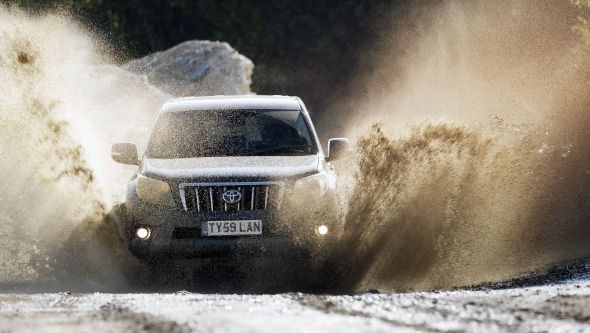
Necessity, the mother of invention
When North Korea invaded South Korea in June 1950, Japan was still under American occupation. As the US and United Nations sprung to South Korea’s assistance, Japanese manufacturers were commissioned to supply compact four-wheel-drive trucks to the US military. Toyota received huge purchase orders for these vehicles, as it had been one of the primary truck suppliers for Japan’s own forces during the 1940s.
But in building vehicles for the Allied forces and these forces being somewhat distracted assisting South Korea, the Japanese people felt vulnerable. A limited re-armament was therefore permitted, including 1000 four-wheel drive vehicles similar in specification to the Willys ‘Jeep’. However, they had to be built using domestically sourced raw materials.

Just five months after being given the go-ahead to start development, January 1951 saw Toyota present its prototype to the National Police Reserve (NPR). It was a parts bin special, using the chassis of Toyota’s one-ton Type SB truck with the oversized 3.4-litre Type B six-cylinder petrol engine of the four-ton truck, suspension from the Toyopet passenger car, and a rudimentary open body.
Unfortunately, the NPR preferred Mitsubishi’s familiar licensed version of the Willys to the Toyota offering. Unperturbed, Toyota saw great potential in its prototype, resolving to continue development and find customers on its own, especially as export restrictions had been lifted the year before.
The legend grows
Advancements were swiftly applied to the ‘Toyota Jeep BJ’ (the initials referred to B-series engine and Jeep) and the vehicle was tested by tackling technological feats that had only previously been possible on horseback – replicating a samurai warrior’s legendary climb to the Shinto temple at the top of Mount Atago, and driving up the old pilgrim route to the sixth station on Mount Fuji. The improved BJ was successful on both events, the reward for Toyota being to replace Mitsubishi as official vehicle supplier to the NPR.

Five different versions sprung from the BJ platform: mobile communications, touring liaison, fire fighter, and two pickups. But it took until August 1953 for the start of series production; by which time a number of other government agencies and energy companies had put in orders for this new vehicle.
In 1954, the hand-me-down ‘Toyota Jeep BJ’ tag was replaced (Willys had since trademarked the name ‘Jeep’) with the descriptively memorable name Land Cruiser. This helped launch the vehicle into export markets, with Pakistan receiving the first shipment later that year and Saudi Arabia following in 1955.
Civilised for civilians
August 1955 saw the introduction of the second-generation (20 series) vehicle, and in the four years following the original concept’s debut it had evolved from military machine to civilian utility vehicle. The changes were dramatic, the new car looking far more civilised with rounded bodywork, integrated headlights, and a more spacious cabin that didn’t make front seat passengers feel like they were conjoined twins.
The short wheelbase model was shorter than before, improving manoeuvrability, while a new long wheelbase model allowed different applications to multiply. Suspension was now partly sourced from the Toyota Crown and was more comfortable for road use, though at this point in time Japan had no highways and reaching just 35mph was deemed exhilarating. Export models therefore ran uprated suspension setups.
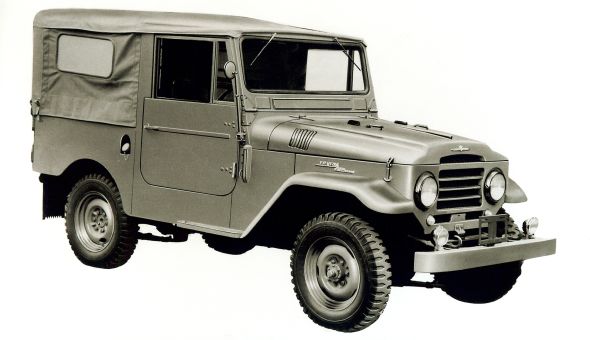
A new cast iron F-series engine was phased in from November 1955 and offered a useful 23% power increase over the outgoing model. A development of the B-series, this low-compression engine first saw the light of day in 1948 and wasn’t discontinued until late 1992, which makes it the longest serving of all Toyota powerplants. It’s widely regarded as one of the most indestructible and unstoppable engines ever produced, holding true to this advertising slogan from its maker: “We’ll know how long it lasts when the first one wears out.”

Acquisitioning success in US military trials in 1957 spurred on Toyota to launch the model in numerous established and emerging export markets. In many cases the Land Cruiser was the first Toyota to arrive on foreign shores. It therefore became the standard-bearer, paving the way for the passenger cars and international sales success that followed. Indeed, of the vehicles of all brands exported from Japan in 1957, 38.2% were Land Cruisers.
The world beater
A fundamental redesign was applied for the third-generation 40 series Land Cruiser for its launch in 1960, though casual onlookers often struggle to tell it apart from its predecessor. It featured slightly more rectangular arches and the indicators had moved to the front wings, but most people recognise the 40 for the lozenge-shaped bezel framing the circular headlamps and radiator grille.
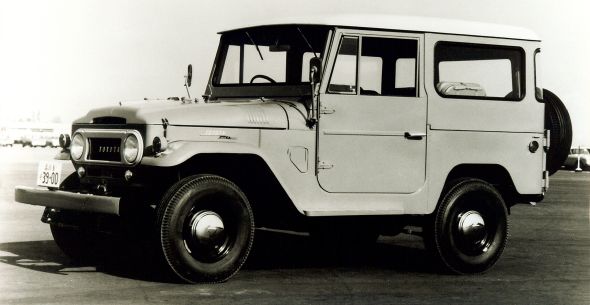
Once again, everything about the Land Cruiser was no-nonsense. The interior featured the bare essentials and nothing more; not even sound insulation. The simple pressed-steel body panels were essentially there to stop the outside coming in, while initial engine choice came entirely from the sturdy F-series range (a smooth H-series diesel was added in 1972 and joined by a four-cylinder B-series model in 1974).
The only thing potential buyers really had to ponder over was to match their choice of final drive ratio with the type of terrain they expected to encounter. ‘Full’, ‘Economy’ or ‘Moderate’ was available, while the carried over three-speed manual transmission now included a transfer case that reduced the overall ratios to provide a total of six forward gears; three for the road and three for off-road.
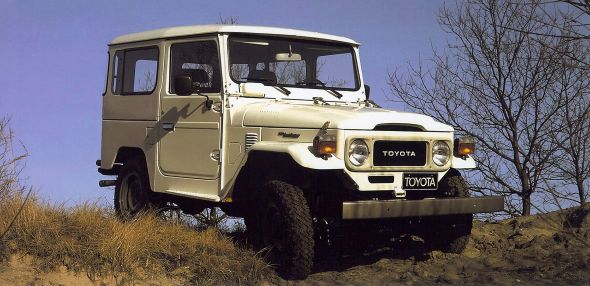
Four wheelbase choices were available, allowing countless permutations from original-style open body to the enclosed troop carrier, or ‘Bush Taxi’, as it is affectionately known in West Africa. Essentially, there was a Land Cruiser to suit everybody’s needs, which led to meteoric sales figures.
In 1965 the 50,000th Land Cruiser rolled off the production line, followed by the 100,000th in 1968. Four years later the total stood at 200,000 examples, while the 800,000th was built in 1979 soon after a minor facelift (the first change in 19 years). The UK started official sales of the Land Cruiser in 1975, and the landmark million was achieved in 1980.

Though Japanese production of the 40 series Land Cruiser ended in 1986, the 40 continued through to late 2001 when the closely related Brazilian special called the Toyota Bandeirante (50 series) eventually finished production. You can therefore say that the body introduced with the 20 series and refined for the 40 enjoyed an incredible 51 years of continuous production. No wonder you can still find examples working for their living throughout the world.
All bases covered
Presentation of the 70 series in 1984 as the successor to the long-serving 40 displayed the more workmanlike side of Land Cruiser, staying close to the original concept while simultaneously responding to market requirements for recreational machines.
In order to compete with other vehicles within the segment Toyota identified that the 70 series should be split into two sections – a robust, leaf-sprung, cargo workhorse, and a more comfortable, people-focussed, coil-sprung version primarily tuned for the European market. The 70 series Land Cruiser therefore arrived to market in two forms – Heavy Duty and Light Duty – and in an almost unimaginable variety of tumbledown models.
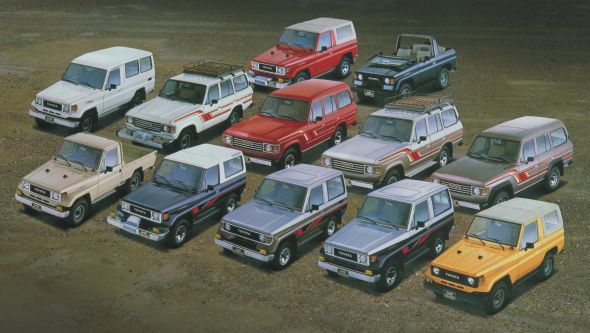
With well over 20 years separating 40 from 70 series, the new Land Cruiser range looked and felt very modern. It shared nothing in common with the older car but the engineering and styling vocabulary were instantly recognisable.
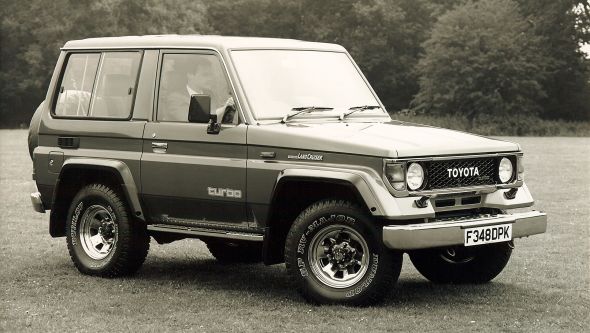
Heavy Duty models were characterised by flat, heavy-gauge steel body panels and a near vertical glasshouse. There was even the suggestion of freestanding front wings thanks to blistered arches emerging from a chunky central crease down the sides. A total of five wheelbase configurations were available, stretching the short model’s 2310mm to the super-long’s 3180mm measurement.
Meanwhile, the engine range was extensive to say the least, initially sharing the same combination of six-cylinder F-series petrol, four-cylinder B-series and six-cylinder H-series diesels as the 60 Station Wagon, but going on to add inline five-cylinder diesel, V6 petrol, and a mighty turbocharged V8 direct injection diesel.
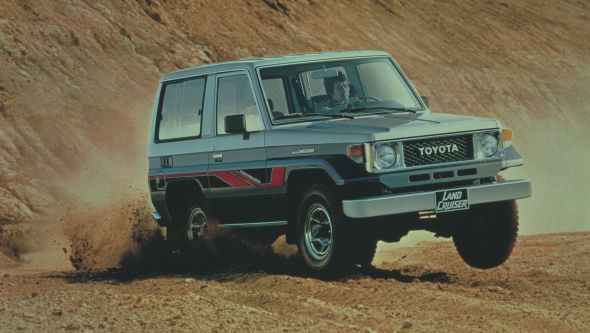
At first glance, Light Duty models (additionally named Bundera and then renamed Prado in 1990) were little different externally or internally. Closer examination from the A-pillar forwards revealed front-ends with more subtly blistered front wings, a bonnet with almost parallel outer edges, and no characteristic gap between the front valance and bumper. Three wheelbases were available, sharing the same measurements as the smaller configurations of the Heavy Duty model.
In contrast, the Light Duty’s engine range was comprised entirely of four-cylinder powerplants, while the lower payload made it possible to suspend the axles on long-stroke coil springs. This not only delivered passenger-car-like comfort but incredible axle articulation – Toyota didn’t want this version to sacrifice anything in terms of off-road ability.
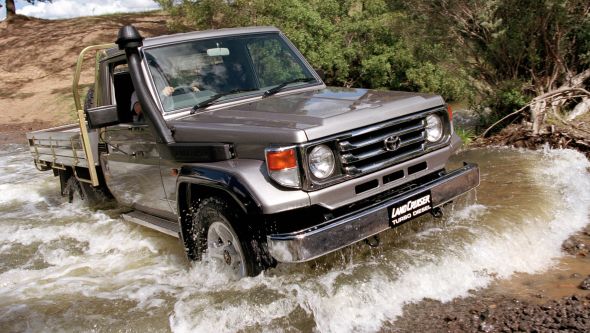
The 70 series Light Duty model was replaced in 1996 by the 90 series. However, the 70 Heavy Duty model soldiered on and underwent its first major revision in 2007, 23 years after it was launched. The front-end was face-lifted with a new headlight and front wing arrangement, and the dashboard was replaced with a more ergonomic design.
In 2009, the dashboard was redesigned again to accommodate twin air bags, which improved passenger safety but also removed the last trace of visible bare metal surface from the interior after 58 years of Land Cruiser history. In 2010, 70 series production surpassed that of the 40, and indeed continues to this day.
State of independence
The Light Duty version of the 70 series had introduced a lifestyle element to the Land Cruiser range, which was then tightened and signalled to the world after its 1990 facelift by changing the name to Land Cruiser Prado.
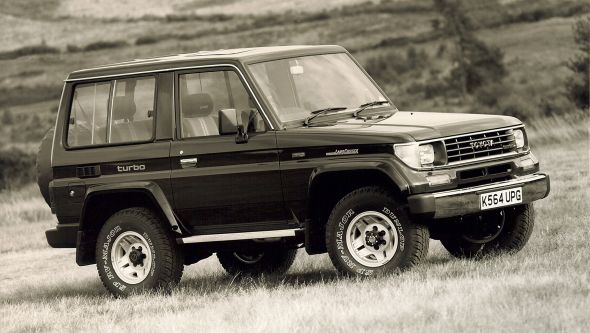
The new, totally independent 90 series launched in 1996 modernised this change of direction, pulling the Prado concept further away from its utilitarian roots to a vehicle that could add ‘driving enjoyment’ and ‘comfort’ to its off-road CV (the car was renamed Land Cruiser Colorado in the UK). It also provided an effective riposte to the Mitsubishi Shogun that had been stealing Toyota’s sales within this sector.
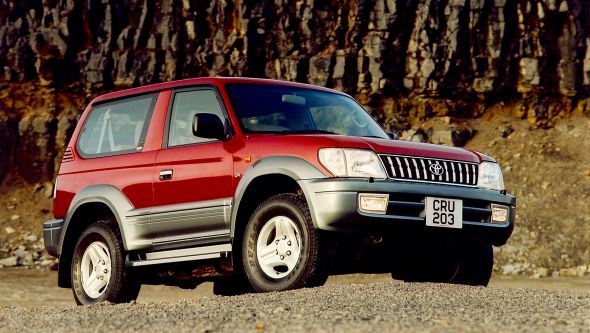
It was a relatively sophisticated machine, featuring an appealing body shape with rising belt line, large plastic bumpers, optional arches, and the simple choice between a three- or five-door shell – no further derivations were available. The perception of space inside could be physically proved with a tape measure, as it was indeed larger in almost every way.
The biggest shock for the off-road community lay underneath the new 90, where the front live axle was replaced with independently sprung front wheels. Any doubts about this supposedly more fragile design – and one that was claimed to reduce ground clearance at the centre of the axle when the suspension was compressed – were allayed when the car’s off-road prowess was tested. In addition, the steering was now by rack and pinion, the preferred setup for road use, and the vast majority of versions featured permanent four-wheel drive.
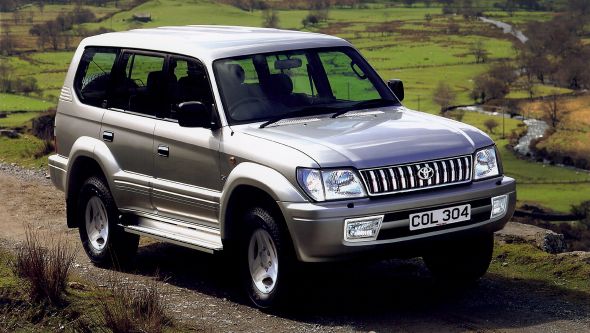
In common with the ethos of the 70 series Light Duty version, the petrol and diesel engine range was primarily focussed on large capacity four-cylinder units of 2.7-litre to 3.0-litre capacities. An all-new 3.4-litre V6 petrol engine was the most powerful option, though the pinnacle of the range was deemed to be the 1KD-FTV 3.0-litre 16v turbocharged and intercooled D-4D, Toyota’s first common rail diesel engine and controlled by an all-singing 32-bit ECU.
Despite its relatively short, seven-year lifespan (product cycles were now much shorter), the 90 series was a resounding success, easily eclipsing its predecessor and achieving almost one eighth of Land Cruiser’s four-million production total by the time it was replaced in 2002.
Talking technical
As the most fashion-conscious side of the Land Cruiser family, the Prado line was the most affected by changing trends. After six years of production the allure of the 90’s styling had faded slightly. However, from 1990 to 2002 the Prado model (70 facelift and 90) had notched up an incredible 760,000 units of the four million Land Cruisers built to that date.
The new 120 series Prado (the Colorado name was dropped from the UK in favour of simply ‘Land Cruiser’) launched at the 2002 Paris motor show and was a technological tour de force, adopting much of the same electronically adjustable suspension specification as the flagship 100 series Station Wagon. It also featured the world’s first electronic hill start assist system that helped gain purchase on slippery slopes, and a downhill assist control to maintain composure when coming back down again.
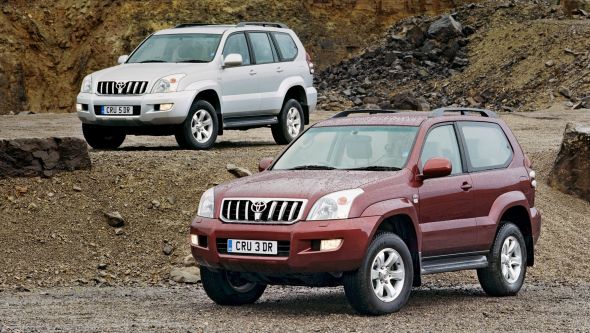
For the first time in its history, the Land Cruiser’s external appearance was penned outside of Japan, in Toyota’s ED2 design centre in southern France. The new aerodynamic aesthetic, and especially the elongated free-form headlights, initially shocked traditionalists but when viewed in the metal it was a pleasing shape with many off-roader styling cues. Its interior was equally smooth, featuring an organically shaped dashboard with a central climate/audio zone that flowed in an S-bend into the centre console.
Both three- and five-door versions were once again available, each variation growing in size compared to the previous generation. However, lower rooflines went some way to minimising that growth visually, while simultaneously lowering the centre of gravity.
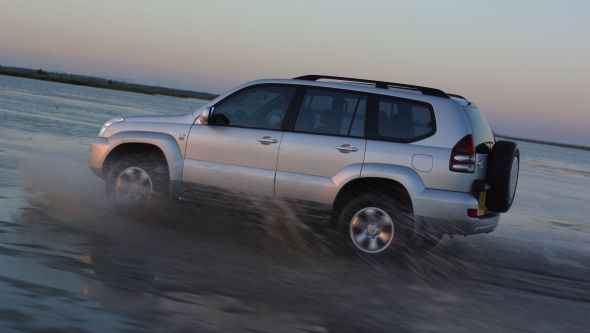
This variety of body styles meant a wide choice of engines – a total of nine different units, though not all were available in every region. Unlike the Station Wagon, the bias here was away from diesel, with two-thirds being petrol engines of four-cylinder, V6 and V8 layouts from 2.7- to 4.7-litre capacities. Engine technology came on in leaps and bounds during production of the 120, so the Prado’s engine range was tweaked throughout its life, improving power, behaviour and emissions.
Retro concept
A surprise appearance at the 2003 Chicago Auto Show was the daring FJ Cruiser design study, which clearly owed much of its retro styling cues to the legendary 40 series (note the lozenge-shape headlamp and grille surround). So well received was the concept that Toyota developed it from the 120 series Prado into a full production model that went on sale in 2006 for the US market only.
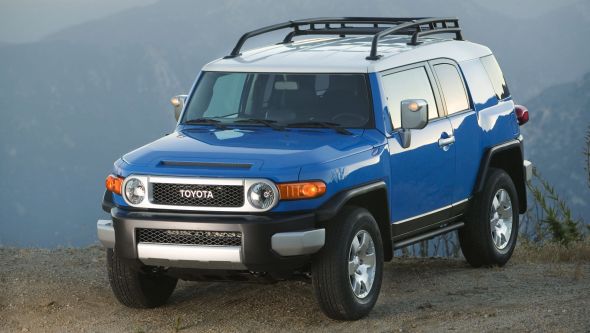
The road-friendly off-roader
Production of the 120 series Prado concluded in late 2008 after seven years of existence and the accumulative achievement of almost six million Land Cruiser sales. It was not deemed to be old, yet Toyota wanted to stay ahead of the curve with its replacement, the important 150 series Prado launched for 2009. This generation would be sold in more than 190 countries worldwide.
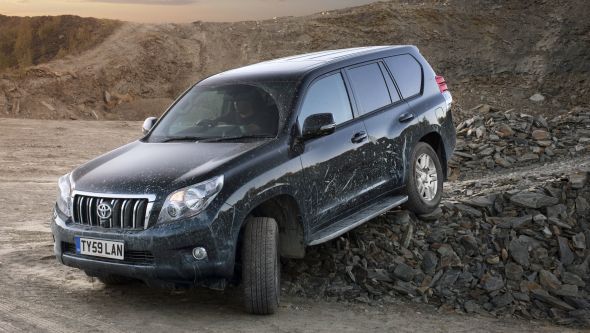
The design was once again handed to ED2, which made subtle visual refinements to the predecessor’s vocabulary while adding hints of the styling cues seen in the recently launched 200 series Station Wagon. It was a more muscular, dynamic look with high-set headlights that raise the outer edges of the bonnet, while for the first time the right-hinged rear door contained a top-hinged window that could be opened independently. Both three- and five-door versions were available, though the wheelbases remained identical to that of the 120. Advancements in the bodyshell’s crash-absorption properties saw the front crumple zone descend to a height similar to that of most passenger cars.
Inside, the sweeping curves of the 120 were replaced with a more robust, functional dashboard design, though the chunky appearance masked improved fit, finish, ergonomics and passive safety measures, including a pre-collision system that would first warn the driver of an impending collision before actively braking the car to avoid contact. Its immense list of features was not dissimilar to that of the 200, which you can take to mean extremely luxurious.
Staying true to its origins, the 150 Prado still featured an extremely rigid ladder frame chassis, but for the first time the car was not available with selectable four-wheel drive. Instead a centrally mounted Torsen differential was used to channel drive between all four wheels – 40:60 from front to back in normal circumstances, 50:50 and 30:70 in more difficult conditions. Compared to previous models, the 150’s engine range was condensed to five units – two diesels and three petrols – all of which were carried over, albeit with the benefit of continuous improvements.
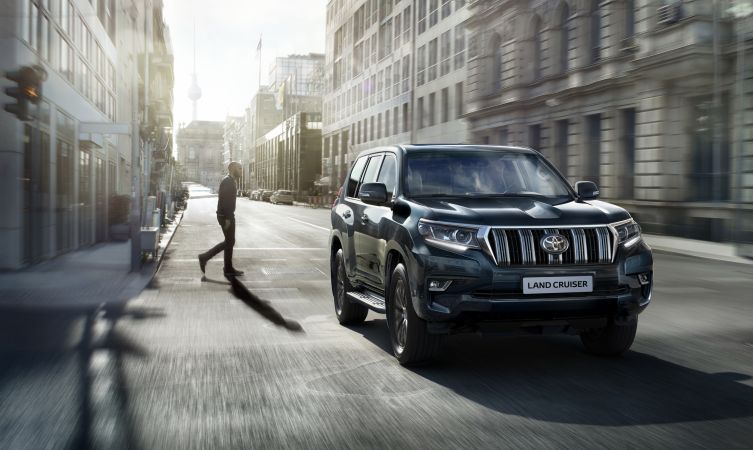
For the 2018 model year (above) the 150 series Prado was refreshed to once again bring it into visual harmony with its 200 series sibling and equip it with the full suite of Toyota Safety Sense systems.
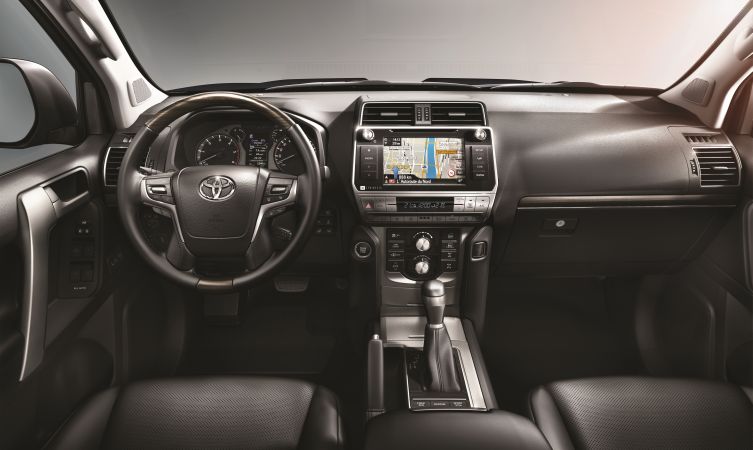
The styling became more robust yet with greater sophistication and road presence in order to boost its appeal within the booming luxury SUV segment. However, for the first time in the UK market it is also available in a United Nations-style Utility specification (below) in either three- or five-door body formats with five seats and a manual, six-speed gearbox. The 2018 range was further broadened with the introduction of a Commercial variant, which deleted the rear seats and see-through rear windows to create generous load space.
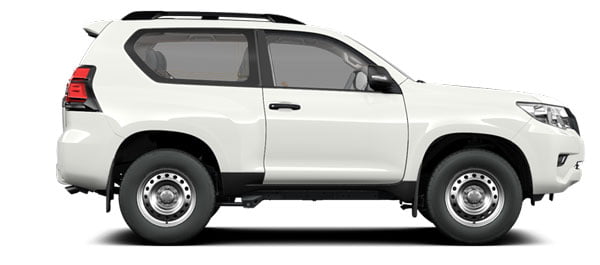
Irrespective of grade, the only engine available in the UK market in the 150 series Land Cruiser is a 2.8-litre four-cylinder turbo diesel unit. From launch, this was a dependable 16-valve D-4D engine that developed 175bhp and up to 450Nm of torque, but in October 2020 it was upgraded to a new unit that offered additional strength (201bhp and 500Nm) and speed with no impact on fuel economy or emissions. In fact, with stop-start technology now fitted as standard, fuel consumption actually improved.
Toyota’s decision to split the Land Cruiser concept into three distinct branches – Station Wagon, Heavy Duty, and Light Duty/Prado – has paid off handsomely. Almost a quarter of the 6.5 million Land Cruisers built to date have carried the Prado name.
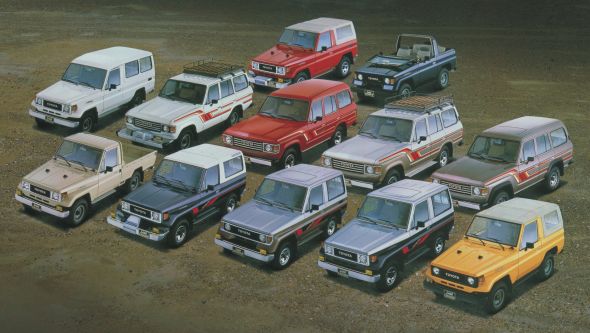
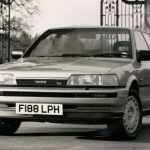
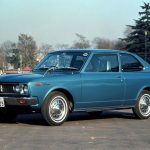


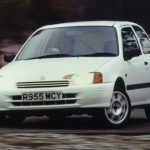
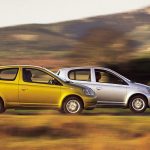

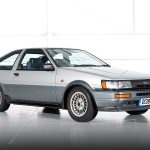


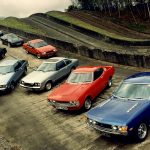


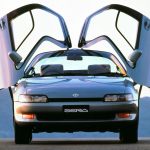
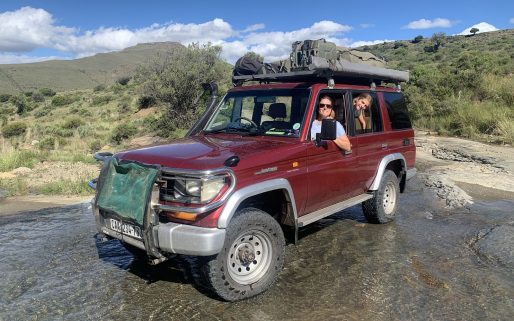
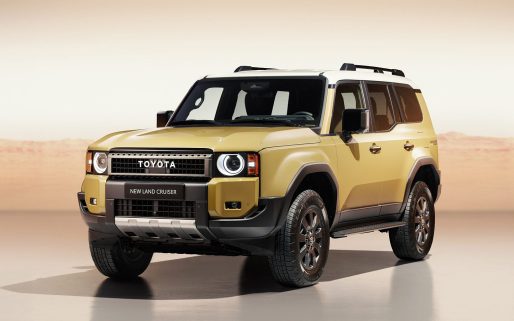
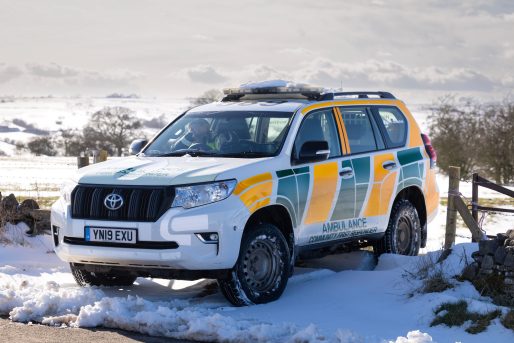
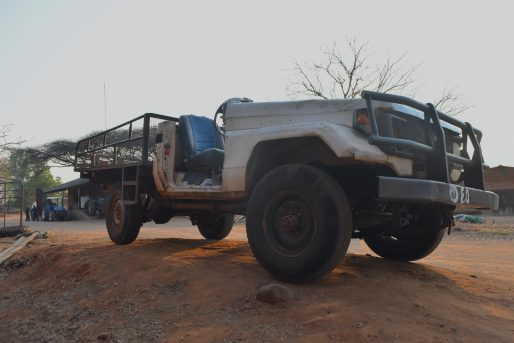
I have two 80 Series Landcruisers and they are the best 4×4’s I have ever owned. These vehicles killed Land Rover and other manufacturers around the world and many still survive with 500K plus miles. So why O why Toyota have you stopped making so many parts for these cars??? My AC doesn’t work in one vehicle due to a split pipe which I can’t now buy. This is crazy and will take these cars off the road. Is this what you want?
Hi Nick,
Thank you for your comment. Unfortunately, due to the number of models in range, we cannot stock all the parts for all the variations of every generation. Therefore we try to stock parts for a minimum of 10 years, after this the factories will focus on making parts for other models. Hope this helps.
You finish your reply with “hope this helps”…. how can your reply possibly help?
I too have an 80 series, owned it for 12 years now. They are without doubt THE Legendary iconic Land Cruiser but, as Nick has said, will slowly be vanishing from the roads due to dwindling parts supplies.
thanks for shearing a nice information.
Hi there,
Thank you for your lovely comments.
One of my favorite cars, the Land Cruisers. Brilliant share!
Hi there,
Thank you for your kind words. 🙂
I have a fj70 1984 model,original 3f engine 356000 km still going strong.my weekend ride due fuel consumption issues
Hi Shadreck Phrir,
Thanks for sharing this with us. We love hearing owners stories. We wish you many more happy miles ahead. Thanks.
Is a 1989 LandCruiser II LJ70 the same as a Bundera or Light Duty or Short Body? How exactly is it different from a 1989 LandCruiser LJ70? Can you explain it in a non gear talk way? I’m not really a car person but I want to understand. Thanks
Hi Andrea,
Thanks for getting in touch.
LJ70 is a model code, so it means the model style is the same, the differences will be down to engine or specs.
Unfortunately as this model was not sold in the UK, we do not have any more information on the specs.
We hope this helps.
Thanks.
Hi i love the land cruiser. So reliable and dependable. Why is it that we cannot buy a landcruiser pickup in the UK without having g to import one?
Hi Corks,
Thanks for getting in touch.
Our Land Cruisers are manufactured in Japan and South Africa, therefore we have to import them to the UK.
Thanks.
We have a Toyota FJ45 Landcruiser which we are told is an ex-Toyota demonstrator, possibly one of the only ones brought into the country by Toyota UK. It was made late 1975 and registered early 1976 so this could be true
The chassis plate is 093629, It is a green FJ45.
Is there any way of finding out its story? We have seen lots of imports of the FJ series but this is the only one we have encountered with a UK reg.
Hi Oscar,
Thanks for getting in touch. It’s great to hear you’re driving an FJ45 Landcruiser and we’d love to see what we can find for you. We have received your private message on Facebook so if you can provide a VIN number we can do a search for you.
Thanks.
HI
Can please share Land Cruiser Sales Start year in UK.
From Starting model With its full name.
Hi there,
Thanks for getting in touch, it’s great to hear your interest in the Land Cruiser. UK sales started in 1975 with the Land Cruiser FJ40.
Hope this helps.
Hi there, is it possible to get the 1989 toyota land cruiser vx turbo LJ 70 seat and door card fabric anymore? Black fading to grey to cream in the centres.
Hi Chelsea,
Thanks for getting in touch. It’s great to hear you still have your 1989 Land Cruiser after all these years. In this case it may be worth contacting an automotive restoration company who may be able to help you further.
Thanks.
Toyota Walkt so the others could RUN!!!
Thanks for your kind words, Johanna!
Are you a Land Cruiser owner yourself?
Thanks.